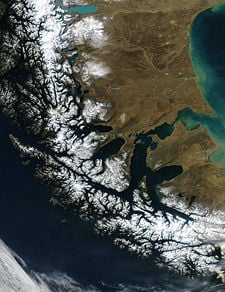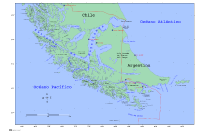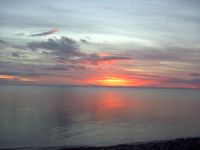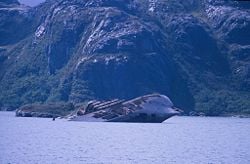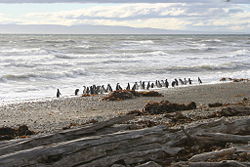Difference between revisions of "Strait of Magellan" - New World Encyclopedia
Mary Anglin (talk | contribs) |
Mary Anglin (talk | contribs) |
||
| Line 31: | Line 31: | ||
In the vicinity of its south arm is the {{convert|1495|m}} [[Monte Burney]], which lies on the mainland's [[Muñoz Gamero Peninsula]]. This imposing volcanic peak stands out from the mountains that surround it. Other mountains in the area include ''Monte Joy'' {{convert|443|m}} and the peaks ''Sainte Agnes'' and ''Sainte Anne'' with elevations of {{convert|323|m}} and {{convert|513|m}} high respectively, which stand on the Manuel Rodríguez Island. | In the vicinity of its south arm is the {{convert|1495|m}} [[Monte Burney]], which lies on the mainland's [[Muñoz Gamero Peninsula]]. This imposing volcanic peak stands out from the mountains that surround it. Other mountains in the area include ''Monte Joy'' {{convert|443|m}} and the peaks ''Sainte Agnes'' and ''Sainte Anne'' with elevations of {{convert|323|m}} and {{convert|513|m}} high respectively, which stand on the Manuel Rodríguez Island. | ||
| − | The '''Magdalena Channel''' joins the Strait of Magellan with [[Cockburn Channel]] and is part of a major navigation route which ultimately connects with the [[Beagle Channel]]. It separates [[Capitán Aracena Island]] from the westernmost portion of [[Isla Grande de Tierra del Fuego]], and crosses [[Alberto de Agostini National Park]]. It is flanked by mountains, the chief of which is the {{convert| | + | The '''Magdalena Channel''' joins the Strait of Magellan with [[Cockburn Channel]] and is part of a major navigation route which ultimately connects with the [[Beagle Channel]]. It separates [[Capitán Aracena Island]] from the westernmost portion of [[Isla Grande de Tierra del Fuego]], and crosses [[Alberto de Agostini National Park]]. It is flanked by mountains, the chief of which is the {{convert|2246|m}} [[Monte Sarmiento]]. Together with the Abra Channel and the Bárbara Channel, it join the westside of the Strait of Magellan directly with the [[Pacific Ocean]]. |
'''Punta Dúngeness''' is a headland at the eastern entrance of the Strait of Magellan on its north shore, opposite Cabo del Espiritu Santo in [[Tierra del Fuego]]. West of the Punta Dungeness lies the [[Bahia Posession]]. Punta Dungeness marks the border between [[Chile]] and [[Argentina]], and according to the [[Treaty of Peace and Friendship of 1984 between Chile and Argentina]] the line between Punta Dungeness and Cabo del Espiritu Santo marks the limits of each country's [[territorial waters]]. It is the southernmost point on the mainland of Argentina, and the easternmost point on the mainland of Chile. There is a lighthouse on the Chilean side. | '''Punta Dúngeness''' is a headland at the eastern entrance of the Strait of Magellan on its north shore, opposite Cabo del Espiritu Santo in [[Tierra del Fuego]]. West of the Punta Dungeness lies the [[Bahia Posession]]. Punta Dungeness marks the border between [[Chile]] and [[Argentina]], and according to the [[Treaty of Peace and Friendship of 1984 between Chile and Argentina]] the line between Punta Dungeness and Cabo del Espiritu Santo marks the limits of each country's [[territorial waters]]. It is the southernmost point on the mainland of Argentina, and the easternmost point on the mainland of Chile. There is a lighthouse on the Chilean side. | ||
| − | '''Dawson Island''' is located southeast of [[Brunswick Peninsula]] and is an approximately | + | '''Dawson Island''' is located southeast of [[Brunswick Peninsula]] and is an approximately {{convert|2000|km2}} tract of land that is often lashed with harsh [[Antarctica|Antarctic]] weather. In the late 1800s the island was used as a [[concentration camp]] for the [[Selknam]] and other native people. Following the 1973 military coup, it was used as a place to house political prisoners. About 30 important political figures involved in [[Salvador Allende]]'s overthrown Popular Unity government were sent to Dawson Island following the coup, alongside some 200 prisoners from the local area. Infamous for its forced labor practices and conditions of squalor, it was shut down in 1974. |
| − | |||
| − | |||
| + | '''Riesco Island''' lies at west of the Brunswick Peninsula. It has an area of {{convert|5110|km2}}. Its highest point is Mount Atalaya at {{convert|1830|m}}. The island is bordered by two large piedmont embayments: [[Otway Sound]] and [[Skyring Sound]]. A narrow channel connects both bodies of water and separates the island from the [[Patagonia]] mainland. The island is separated from the southern part of the [[Muñoz Gamero Peninsula]] by another narrow channel. [[Glacier]]s occur on Riesco. In the north, an icefield is the source of seven glaciers, while there are 12 glaciers on the slopes of ''Cerro Ladrillero''. In the southern portion of the island, ''Córdova Peninsula'' marks the eastern limit of the Strait of Magellan and is home to several mountain glaciers. | ||
| + | Riesco Island hosts Chile's largest known [[coal]] reserves. It is believed to contain more than 300 million tonnes of low-quality coal in three deposits: ''Río Eduardo'', ''Elena'' and ''Estancia Invierno''. | ||
| + | [[Image:Magellanic penguin4.jpg|250px|right|thumb|Seno Otway [[Magellanic Penguin]] Colony]] | ||
| + | '''Seno Otway''' is a large inland [[Sound (geography)|sound]] lying between Brunswick Peninsula and Riesco Island. Alternatively called '''Otway Sound''', this natural waterway occupies a valley blocked by a large [[terminal moraine]] left by the retreat of a [[glacier]] during the [[last glacial period]]. In spite of being located east of the [[Andes]], it is connected to the open [[Pacific Ocean]] through the Strait of Magellan via a narrow passage which cuts into the Andean Massif. Seno Otway also is [[hydrological]]ly connected with [[Seno Skyring]] by the [[FitzRoy Channel]]. | ||
| + | There are a variety of marine species within the Otway Sound, as well as along the coastal terrestrial and [[intertidal]] zones. Notably there is a moderately large colony of the [[Magellanic Penguin]] along the coast. | ||
==History== | ==History== | ||
| Line 61: | Line 64: | ||
==References== | ==References== | ||
| + | * C. Michael Hogan. November 27, 2008. [http://globaltwitcher.auderis.se/artspec_information.asp?thingid=232 Magellanic Penguin] ''Global Twitcher''. Retrieved February 14, 2009. | ||
| + | * ''Derechos Chile.'' [http://www.chipsites.com/derechos/campo_isla_dawson_eng.html Human rights in Chile: Dawson Island] Retrieved February 14, 2009. | ||
* ''Google''. [http://www.google.com/archivesearch?q=Strait+of+Magellan&oe=utf-8&rls=org.mozilla:en-US:official&client=firefox-a&um=1&ie=UTF-8&scoring=t&ei=YQSVSe7eF4nYsAOO6_29Bw&sa=X&oi=timeline_result&resnum=15&ct=title Timeline for Strait of Magellan] Retrieved February 13, 2009. | * ''Google''. [http://www.google.com/archivesearch?q=Strait+of+Magellan&oe=utf-8&rls=org.mozilla:en-US:official&client=firefox-a&um=1&ie=UTF-8&scoring=t&ei=YQSVSe7eF4nYsAOO6_29Bw&sa=X&oi=timeline_result&resnum=15&ct=title Timeline for Strait of Magellan] Retrieved February 13, 2009. | ||
*''ISMAR Bologna''. [http://projects.bo.ismar.cnr.it/OCEANS/CHILE/SCPM04_REP/node10.html The Straits of Magellan and Oceanographical Setting] Retrieved February 13, 2009. | *''ISMAR Bologna''. [http://projects.bo.ismar.cnr.it/OCEANS/CHILE/SCPM04_REP/node10.html The Straits of Magellan and Oceanographical Setting] Retrieved February 13, 2009. | ||
| Line 71: | Line 76: | ||
[[Category:Geography]] | [[Category:Geography]] | ||
[[Category:Landforms]] | [[Category:Landforms]] | ||
| − | {{credit|Strait_of_Magellan|268939324|253501543|Magdalena_Channel|253501484|Punta_Dúngeness|270516680}} | + | {{credit|Strait_of_Magellan|268939324|Smyth_Channel|253501543|Magdalena_Channel|253501484|Punta_Dúngeness|270516680|Dawson_Island|253500212|Riesco_Island|253500017|Seno_Otway|256982721}} |
Revision as of 01:51, 14 February 2009
The Strait of Magellan (often referred to as the Straits of Magellan and rarely as the Magellanic Strait) is a channel at the tip of South America linking the Atlantic and Pacific Oceans. This navigable sea route separates the mainland from Tierra del Fuego and other islands south of the continent. Except for a few miles at its easternmost extremity in Argentina, it lies within Chilean territorial waters. The strait’s major port is Punta Arenas on the Brunswick Peninsula.
The strait is approximately 600 kilometers (370 mi) long, and ranges from 3 to 35 kilometers (1.9 to 22 mi) at its narrowest and widest points, respectively. An important natural passage between the oceans, it is considered a difficult route to navigate because of the inhospitable climate and the narrowness of the passage.
The first European to navigate the strait was Ferdinand Magellan, a Portuguese maritime explorer sailing for Spain, who discovered the strait in 1520 during the first successful attempt at world circumnavigation.
The strait was an important sailing-ship route before the completion of the Panama Canal in 1914 shortened the Atlantic-Pacific passage by several thousand miles. Though it follows a difficult and often foggy path among numerous islands and channels, it allows an inland passage protected from almost continuous ocean storms. It continues to be used by ships rounding South America.
Geography
Course
The Strait of Magellan is approximately 600 kilometers (370 mi) long, and ranges from 3 to 35 kilometers (1.9 to 22 mi) at its narrowest and widest points, respectively. The northwestern portion of the strait is connected with other sheltered waterways via the Smyth Channel. This area is similar to those of the Inside Passage of Alaska. Southward from Cape Froward, the principal shipping route follows through the Magdalena Channel. It links the strait with the Beagle Channel.
The eastern opening is the wide bay on the border of Chile and Argentina between Punta Dúngeness on the mainland and Cabo del Espiritu Santo on Tierra del Fuego, the border defined in the Treaty of Peace and Friendship of 1984 between Chile and Argentina. Immediately west are located Primera Angostura and Segunda Angostura, which are narrows formed by two different-aged terminal moraines. Here also lies Magdalena Island, which is part of Los Pingüinos Natural Monument, home of the largest penguin colonies of south Chile, including an estimated 60,000 breeding pairs of the Magellanic Penguin. In this part of the strait, its southern boundary follows first the shoreline of the Isla Grande de Tierra del Fuego, then follows the northern end of the Canal Whiteside and continues along the shoreline of Dawson Island.
The western part of the strait stretches northwestward from the northern end of Magdalena Channel to the strait's Pacific entrance. This portion of the strait is flanked on the south by Capitán Aracena Island, Clarence Island, Santa Inés Island, Desolación Island and other smaller islands, and on the north by Brunswick Peninsula, Riesco Island, Muñoz Gamero Peninsula and other minor islands. Here, two narrow channels that open into the strait connect with Seno Otway and Seno Skyring. Francisco Coloane Coastal and Marine Protected Area, which protects Humpback Whales, is located in this area. This part of the strait lies on the elongated Magallanes-Fagnano Fault, which marks a plate boundary between the South American Plate and the Scotia Plate. This fault continues southward under the Almirantazgo Fjord and then low the Fagnano Lake.
Features
The Smyth Channel is a principal Patagonian channel. Its south arm is the southward continuation of the Sarmiento Channel. Its north entrance is in the Nelson Strait and its southern terminus is at the point of alignment of the Phillip Cape in the southern extreme of Manuel Rodríguez Island with the mainland peninsula Merino, at which point it opens into the Strait of Magellan.
The channel has a length of approximately 96 nautical miles (178 km/110 mi) and is divided into two arms: the northwest arm, which is rarely used as navigation route and is 50 nautical miles (93 km/58 mi) long, and the south arm 46 nautical miles (85 km/53 mi) long, which is a major waterway for commercial sailing and that stretches from its connection with the Sarmiento Channel at southern tip of the Victoria Pass until the point where it joins the Strait of Magellan.
The channel is flanked by mountain ranges of exposed granite that at their foothills have limited vegetation cover due to continuous strong winds. In the northwest arm the hills are high, including the Monte Nuestra Señora de la Victoria 890 meters (2,900 ft) and the Lecky Look Out 890 meters (2,900 ft) on the Contreras Island, and the Monte Lucía of 510 meters (1,700 ft) on the Diego de Almagro Island.
In the vicinity of its south arm is the 1,495 meters (4,900 ft) Monte Burney, which lies on the mainland's Muñoz Gamero Peninsula. This imposing volcanic peak stands out from the mountains that surround it. Other mountains in the area include Monte Joy 443 meters (1,450 ft) and the peaks Sainte Agnes and Sainte Anne with elevations of 323 meters (1,060 ft) and 513 meters (1,680 ft) high respectively, which stand on the Manuel Rodríguez Island.
The Magdalena Channel joins the Strait of Magellan with Cockburn Channel and is part of a major navigation route which ultimately connects with the Beagle Channel. It separates Capitán Aracena Island from the westernmost portion of Isla Grande de Tierra del Fuego, and crosses Alberto de Agostini National Park. It is flanked by mountains, the chief of which is the 2,246 meters (7,370 ft) Monte Sarmiento. Together with the Abra Channel and the Bárbara Channel, it join the westside of the Strait of Magellan directly with the Pacific Ocean.
Punta Dúngeness is a headland at the eastern entrance of the Strait of Magellan on its north shore, opposite Cabo del Espiritu Santo in Tierra del Fuego. West of the Punta Dungeness lies the Bahia Posession. Punta Dungeness marks the border between Chile and Argentina, and according to the Treaty of Peace and Friendship of 1984 between Chile and Argentina the line between Punta Dungeness and Cabo del Espiritu Santo marks the limits of each country's territorial waters. It is the southernmost point on the mainland of Argentina, and the easternmost point on the mainland of Chile. There is a lighthouse on the Chilean side.
Dawson Island is located southeast of Brunswick Peninsula and is an approximately 2,000 square kilometers (770 sq mi) tract of land that is often lashed with harsh Antarctic weather. In the late 1800s the island was used as a concentration camp for the Selknam and other native people. Following the 1973 military coup, it was used as a place to house political prisoners. About 30 important political figures involved in Salvador Allende's overthrown Popular Unity government were sent to Dawson Island following the coup, alongside some 200 prisoners from the local area. Infamous for its forced labor practices and conditions of squalor, it was shut down in 1974.
Riesco Island lies at west of the Brunswick Peninsula. It has an area of 5,110 square kilometers (1,970 sq mi). Its highest point is Mount Atalaya at 1,830 meters (6,000 ft). The island is bordered by two large piedmont embayments: Otway Sound and Skyring Sound. A narrow channel connects both bodies of water and separates the island from the Patagonia mainland. The island is separated from the southern part of the Muñoz Gamero Peninsula by another narrow channel. Glaciers occur on Riesco. In the north, an icefield is the source of seven glaciers, while there are 12 glaciers on the slopes of Cerro Ladrillero. In the southern portion of the island, Córdova Peninsula marks the eastern limit of the Strait of Magellan and is home to several mountain glaciers.
Riesco Island hosts Chile's largest known coal reserves. It is believed to contain more than 300 million tonnes of low-quality coal in three deposits: Río Eduardo, Elena and Estancia Invierno.
Seno Otway is a large inland sound lying between Brunswick Peninsula and Riesco Island. Alternatively called Otway Sound, this natural waterway occupies a valley blocked by a large terminal moraine left by the retreat of a glacier during the last glacial period. In spite of being located east of the Andes, it is connected to the open Pacific Ocean through the Strait of Magellan via a narrow passage which cuts into the Andean Massif. Seno Otway also is hydrologically connected with Seno Skyring by the FitzRoy Channel.
There are a variety of marine species within the Otway Sound, as well as along the coastal terrestrial and intertidal zones. Notably there is a moderately large colony of the Magellanic Penguin along the coast.
History
Ferdinand Magellan (the original name, in Portuguese, Fernão de Magalhães), a Portuguese sailor in service to the Spanish King, became the first European to navigate the strait in 1520, during his global circumnavigation voyage. Because Magellan's ships entered it on November 1, All Saints' Day, it was originally named Estrecho de Todos los Santos (Strait of All Saints). Later the Spanish king changed the name to Estrecho de Magallanes in honor of Magellan. Since its discovery the Spanish Empire and the Kingdom of Chile saw it as its southern boundary. The first Spanish colonization attempt was led by Pedro Sarmiento de Gamboa who founded Nombre de Jesús and Rey Don Felipe on its northern shores. The cities suffered severe food shortages, and years afterwards in 1587 the English navigator Sir Thomas Cavendish landed at the site of Rey Don Felipe and found only ruins of the settlement. He renamed the place Port Famine. Other early explorers included Francis Drake. The strait was first carefully explored and thoroughly charted by Phillip Parker King, who commanded the British survey vessel HMS Adventure, and in company with HMS Beagle, spent five years surveying the complex coasts around the Strait. The result was presented at a meeting of the Royal Geographical Society in 1831.
Incorporation to Chile
Chile took possession of the channel on May 23, 1843. Chilean president Bulnes ordered the expedition after speaking with the Chilean libertador Bernardo O'Higgins who feared an occupation by Great Britain or France. The first Chilean settlement was Fuerte Bulnes situated in a forested zone on the north side of the strait. Fuerte Bulnes was later abandoned and the city of Punta Arenas was founded in 1848 further north where the Magellanic forests met the Patagonian plains. In front of Punta Arenas, on the other shore of the strait in Tierra del Fuego the village of Porvenir emerged during a gold rush in the late 1800s.
Until the Panama Canal was finished in 1914, the Strait of Magellan was the main route for steam ships traveling from the Atlantic Ocean to the Pacific; it was often considered the only safe way to move between the Atlantic and Pacific Oceans. Protected by Tierra del Fuego to the south and the bulk of South America to the north, ships crossed with relative ease, removed from the dangers of Drake Passage. Despite these natural defenses, sailing ships such as the clippers preferred Drake Passage as they had more room to maneuver. The Drake Passage is the relatively narrow stretch of ocean separating Cape Horn (the southern tip of South America) from Antarctica, the waters of which are notoriously turbulent, unpredictable, and frequented by icebergs and sea ice.
Notes
ReferencesISBN links support NWE through referral fees
- C. Michael Hogan. November 27, 2008. Magellanic Penguin Global Twitcher. Retrieved February 14, 2009.
- Derechos Chile. Human rights in Chile: Dawson Island Retrieved February 14, 2009.
- Google. Timeline for Strait of Magellan Retrieved February 13, 2009.
- ISMAR Bologna. The Straits of Magellan and Oceanographical Setting Retrieved February 13, 2009.
- Kent, Rockwell. 2000. Voyaging southward form the Strait of Magellan. Hanover, NH [u.a.]: Univ. Press of New England. ISBN 9780819564092
- Markham, Clements R. 1911. Early Spanish voyages to the strait of Magellan. Works issued by the Hakluyt Society, 2nd ser., no. 28. London: Printed for the Hakluyt Society. OCLC 9060328
- Morris, Michael A. 1989. The Strait of Magellan. International straits of the world, v. 11. Dordrecht: M. Nijhoff. ISBN 9780792301813
- U.S. Geological Survey. Past Glaciations and "Little Ice Ages" Retrieved February 13, 2009.
Credits
New World Encyclopedia writers and editors rewrote and completed the Wikipedia article in accordance with New World Encyclopedia standards. This article abides by terms of the Creative Commons CC-by-sa 3.0 License (CC-by-sa), which may be used and disseminated with proper attribution. Credit is due under the terms of this license that can reference both the New World Encyclopedia contributors and the selfless volunteer contributors of the Wikimedia Foundation. To cite this article click here for a list of acceptable citing formats.The history of earlier contributions by wikipedians is accessible to researchers here:
- Strait_of_Magellan history
- Smyth_Channel history
- Magdalena_Channel history
- Punta_Dúngeness history
- Dawson_Island history
- Riesco_Island history
- Seno_Otway history
The history of this article since it was imported to New World Encyclopedia:
Note: Some restrictions may apply to use of individual images which are separately licensed.
